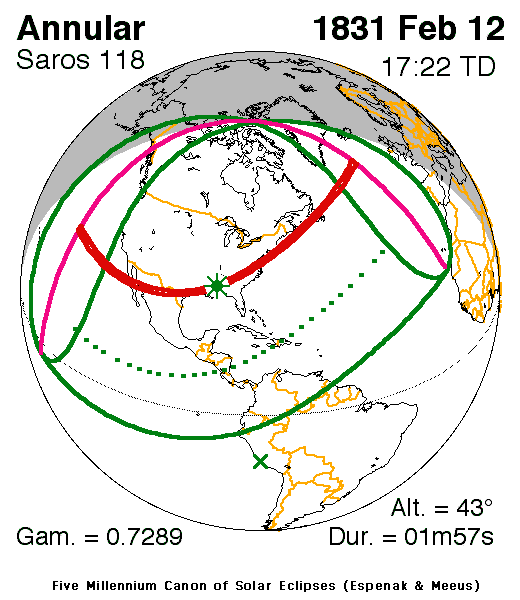An annular eclipse of the Sun occurred on Saturday 12 February, 1831 UT (31 Jan, 1831 Old Style), with maximum eclipse at 17:21 UT. A large annular eclipse covered 98% of the Sun, creating a dramatic spectacle for observers in a path up to 100 km wide; it lasted 1 minute and 57 seconds at the point of maximum eclipse. It was seen across northern Mexico, the eastern USA, and eastern Canada. The partial eclipse was visible from most of North America.
The annular eclipse lasted for 1 minute and 57 seconds.
Maximum eclipse was at 17:21:38 UT.
During this eclipse the Sun was 0.540° in apparent
diameter, 1.3% larger than average. The Moon was 7 days after apogee and 5 days before perigee.
At maximum eclipse it was 0.529° in
apparent diameter, which is around average; this was not
large enough to cover the Sun, which is why this
was an annular eclipse.
The statistics page has information on the ranges of the sizes of
the Sun and Moon, and the Moon data page displays detailed
information on the Moon's key dates.
Nat Turner was inspired to begin his slave rebellionNat Turner's slave rebellion
Article on the slave rebellion instigated in 1831 in Virginia by Nat Turner. The eclipse of 12 February inspired him to begin his action. (Wikipedia)
by this eclipse, which was seen in Virginia.
Overview Map
This map sourced from NASA Goddard Space flight Center: GSFC Eclipse Web SiteGSFC Eclipse Web Site
The primary source of all the information on eclipses presented here at Hermit Eclipse. (NASA Goddard Space flight Center)
shows the visibility of the annular solar eclipse. It also shows the broader area in which a partial eclipse was seen. (Click on it for the
full-sized version.)
Eclipse Season and Saros Series
This eclipse season contains 2 eclipses:
This was the 58th eclipse in solar Saros series 118.The surrounding eclipses in this Saros series are:
This Saros series, solar Saros series 118,
is linked to lunar Saros series 111. The
nearest partner eclipses in that series are:
Eclipse Parameters
| UT Date/time (max) | 17:21:38 on 12 Feb UT |
TDT Date/time (max) | 17:21:45 on 12 Feb TDT |
| Saros Series | 118 |
Number in Series | 58 |
| Penumbral Magnitiude | |
Central Magnitiude | 0.9807 |
| Gamma | 0.7288 |
Path Width (km) | 100 |
| Delta T | 0m07s |
Error | ± 0m01s (95%) |
| Penumbral Duration | |
Partial Duration | |
| Total Duration | 1m57s |
| |
| Partial Rating | |
Total Rating | |
| Sun Distance | 147753081 km (13.6%) |
Moon Distance | 380323 km (47.6%) |
| Sun Diameter | 0.540° |
Moon Diameter | 0.523° - 0.529° |
| Apogee | 07:12 on 5 Feb UT |
Perigee | 04:18 on 18 Feb UT |
Note that while all dates and times on this site (except
where noted) are in UT, which is within a second of civil time,
the dates and times shown in NASA's eclipse listingsGSFC Eclipse Web Site
The primary source of all the information on eclipses presented here at Hermit Eclipse. (NASA Goddard Space flight Center)
are in the TDT timescale.
The Sun and Moon distances are shown in km, and as a
percentage of their minimum - maximum distances; hence 0%
is the closest possible (Earth's perihelion, or the
Moon's closest possible perigee) and 100% is
the farthest (aphelion, the farthest apogee).
The statistics page has information on the ranges of sizes
of the Sun and Moon, and the Moon data page displays detailed
information on the Moon's key dates.
Data last updated: 2015-06-21 22:11:46 UTC.

